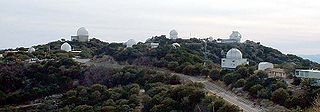
The Kitt Peak National Observatory (KPNO) is a United States astronomical observatory located on Kitt Peak of the Quinlan Mountains in the Arizona-Sonoran Desert on the Tohono O'odham Nation, 88 kilometers (55 mi) west-southwest of Tucson, Arizona. With more than twenty optical and two radio telescopes, it is one of the largest gatherings of astronomical instruments in the northern hemisphere.
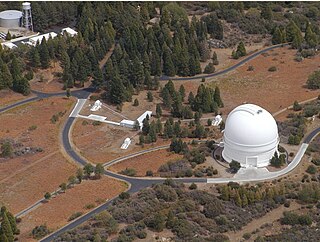
Palomar Observatory is an astronomical research observatory in San Diego County, California, United States, in the Palomar Mountain Range. It is owned and operated by the California Institute of Technology (Caltech). Research time at the observatory is granted to Caltech and its research partners, which include the Jet Propulsion Laboratory (JPL), Yale University, and the National Optical Observatories of China.
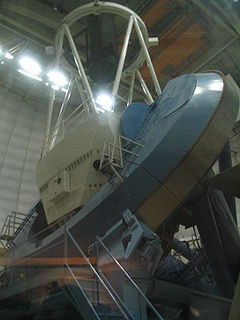
Observational astronomy is a division of astronomy that is concerned with recording data about the observable universe, in contrast with theoretical astronomy, which is mainly concerned with calculating the measurable implications of physical models. It is the practice and study of observing celestial objects with the use of telescopes and other astronomical instruments.

The Apache Point Observatory is an astronomical observatory located in the Sacramento Mountains in Sunspot, New Mexico, United States, approximately 18 miles (29 km) south of Cloudcroft. The observatory is operated by New Mexico State University (NMSU) and owned by the Astrophysical Research Consortium (ARC). Access to the telescopes and buildings is private and restricted.
Nuwa is a large main-belt asteroid with an orbital period of 5.15 years. It was discovered by Canadian-American astronomer James Craig Watson on October 18, 1875, and named after Nüwa, the Chinese creator goddess. This object is a candidate member of the Hecuba group of asteroids that orbit near the 2:1 mean-motion resonance with Jupiter. Based upon the spectrum it is classified as a C-type asteroid, which indicates that it is probably composed of primitive carbonaceous chondritic material and the surface is exceedingly dark.

The Hale Telescope is a 200-inch (5.1 m), f/3.3 reflecting telescope at the Palomar Observatory in San Diego County, California, US, named after astronomer George Ellery Hale. With funding from the Rockefeller Foundation in 1928, he orchestrated the planning, design, and construction of the observatory, but with the project ending up taking 20 years he did not live to see its commissioning. The Hale was groundbreaking for its time, with double the diameter of the second-largest telescope, and pioneered many new technologies in telescope mount design and in the design and fabrication of its large aluminum coated "honeycomb" low thermal expansion Pyrex mirror. It was completed in 1949 and is still in active use.
A small telescope is generally considered by professional astronomers to be any reflecting telescope with a primary mirror that is less than 2 metres (80 in) in diameter. By amateur standards, a small telescope can have a primary mirror/aperture less than 6–10 inches (150–250 mm) in diameter. Little if any professional-level research is performed with refracting telescopes in the modern era of astronomy.
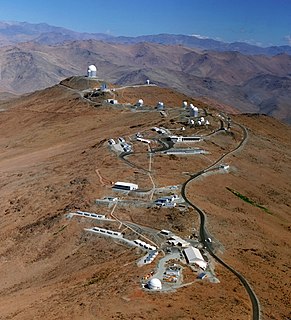
La Silla Observatory is an astronomical observatory in Chile with three telescopes built and operated by the European Southern Observatory (ESO). Several other telescopes are located at the site and are partly maintained by ESO. The observatory is one of the largest in the Southern Hemisphere and was the first in Chile to be used by ESO.

Siding Spring Observatory near Coonabarabran, New South Wales, Australia, part of the Research School of Astronomy & Astrophysics (RSAA) at the Australian National University (ANU), incorporates the Anglo-Australian Telescope along with a collection of other telescopes owned by the Australian National University, the University of New South Wales, and other institutions. The observatory is situated 1,165 metres (3,822 ft) above sea level in the Warrumbungle National Park on Mount Woorat, also known as Siding Spring Mountain. Siding Spring Observatory is owned by the Australian National University (ANU) and is part of the Mount Stromlo and Siding Spring Observatories research school.

Neil Gehrels Swift Observatory, previously called the Swift Gamma-Ray Burst Explorer, is a NASA three-telescope space observatory for studying gamma-ray bursts (GRBs) and monitoring the afterglow in X-ray, and UV/Visible light at the location of a burst. It was launched on 20 November 2004, aboard a Delta II launch vehicle. Headed by principal investigator Neil Gehrels, at Goddard Space Flight Center (GSFC), the mission was developed in a joint partnership between GSFC and an international consortium from the United States, United Kingdom, and Italy. The mission is operated by Pennsylvania State University as part of NASA's Medium Explorer program (MIDEX).
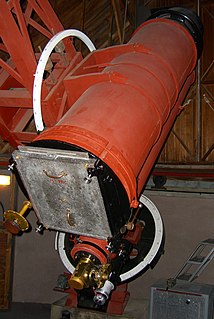
An astrograph is a telescope designed for the sole purpose of astrophotography. Astrographs are mostly used in wide-field astronomical surveys of the sky and for detection of objects such as asteroids, meteors, and comets.
Leuschner Observatory, originally called the Students' Observatory, is an observatory jointly operated by the University of California, Berkeley and San Francisco State University. The observatory was built in 1886 on the Berkeley campus. For many years, it was directed by Armin Otto Leuschner, for whom the observatory was renamed in 1951. In 1965, it was relocated to its present home in Lafayette, California, approximately 10 miles (16 km) east of the Berkeley campus. In 2012, the physics and astronomy department of San Francisco State University became a partner.

Konkoly Observatory is an astronomical observatory located in Budapest, Hungary is part of the Research Centre for Astronomy and Earth Sciences and belongs to the Eötvös Loránd Kutatási Hálózat. It was founded in 1871 by Hungarian astronomer Miklós Konkoly-Thege (1842–1916) as a private observatory, and was donated to the state in 1899. Konkoly Observatory, officially known as ELKH CSFK Konkoly Thege Miklós Csillagászati Intézet in Hungarian, is the largest astronomical research institute in Hungary, and hosts the largest telescopes in the country. The Observatory has more than 60 researchers, a quarter of them are non-Hungarian.
Slooh is a robotic telescope service that can be viewed live through a web browser. It was not the first robotic telescope, but it was the first that offered "live" viewing through a telescope via the web. Other online telescopes traditionally email a picture to the recipient. The site has a patent on their live image processing method. Slooh is an online astronomy platform with live-views and telescope rental for a fee. Observations come from a global network of telescopes located in places including Spain and Chile.

The Panoramic Survey Telescope and Rapid Response System located at Haleakala Observatory, Hawaii, US, consists of astronomical cameras, telescopes and a computing facility that is surveying the sky for moving or variable objects on a continual basis, and also producing accurate astrometry and photometry of already-detected objects. In January 2019 the second Pan-STARRS data release was announced. At 1.6 petabytes, it is the largest volume of astronomical data ever released.
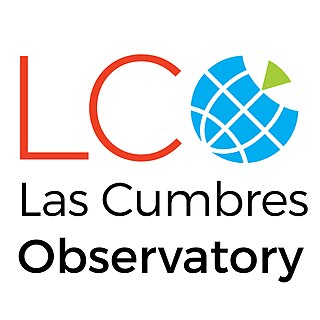
Las Cumbres Observatory (LCO) is a network of astronomical observatories run by a non-profit private operating foundation directed by the technologist Wayne Rosing. Its offices are in Goleta, California. The telescopes are located at both northern and southern hemisphere sites distributed in longitude around the Earth. For some astronomical objects, the longitudinal spacing of telescopes allows continuous observations over 24 hours or longer. The operating network currently consists of two 2 meter telescopes, nine 1 meter telescopes, and seven 40 cm telescopes, placed at six astronomical observatories. The network operates as a single, integrated, observing facility, using a software scheduler that continuously optimizes the planned observing schedule of each individual telescope.

The Mont Mégantic Observatory is an astronomical observatory owned and operated jointly by the Université de Montréal (UdeM), and the Université Laval (ULaval). Founded in 1978, the observatory houses the second largest telescope in Eastern Canada after David Dunlap Observatory near Toronto. It is situated at the summit of Mont Mégantic, the highest point of Eastern Canada accessible by car. OMM is about 60 kilometres (37 mi) east of Sherbrooke and 190 kilometres (120 mi) east of Montreal.

PROMPT, an acronym for Panchromatic Robotic Optical Monitoring and Polarimetry Telescopes, is being built by the University of North Carolina at Chapel Hill at Cerro Tololo Inter-American Observatory (CTIO) in Chile. PROMPT's primary objective is rapid and simultaneous multiwavelength observations of gamma-ray burst afterglows, some when they are only tens of seconds old. In addition to measuring redshifts by dropout, and early-time SFDs and extinction curves of sufficiently bright afterglows in unprecedented detail, PROMPT will facilitate quick response observations at larger observatories such as the UNC-led 4.1-m SOAR Telescope. PROMPT will also serve as a platform for undergraduate and high school education throughout the State of North Carolina.
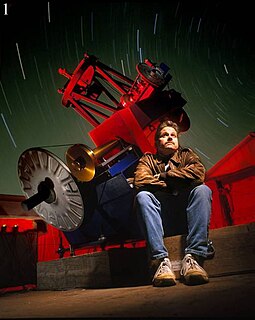
Puckett Observatory is a private astronomical observatory located in the state of Georgia. It is owned and operated by Tim Puckett. Its primary observation goals are the study of comets and the discovery of supernovae. To facilitate the latter goal it sponsors the Puckett Observatory World Supernova Search whose astronomers have discovered 369 supernovae.

















